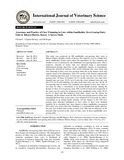| dc.identifier.citation | Kimeli, P., Nguhiu-Mwangi, J., Mogoa, E. M., & Kangemi, K. (2014). International Journal of Veterinary Science. | en_US |
| dc.description.abstract | This study was conducted in 100 smallholder zero-grazing dairy units in
Kikuyu district, Kiambu county of Kenya. The objective was to evaluate how
much smallholder farmers knew about the importance of claw trimming and
whether or not it is practiced in the smallholder zero-grazing dairy units. After a
purposive selection of farms, data was obtained using a questionnaire
administered through interviews to the smallholder farmers as respondents.
Among the interviewed farmers, 94% (n=94) indicated they were aware that
claw trimming in dairy cows was essential while 6% of the farmers were only
vaguely aware of its importance. Only 43% (n=43) of the farmers reported that
claw trimming had been done at least once in the last one year in their zerograzing
units. Of these 43 farmers, 65.1% (n=28) said their cows had claws
trimmed once per year, 30.2% (n=13) said they were trimmed twice per year
and 4.7% (n=2) said trimming was done more than twice per year. In the 43
zero-grazing units in which claw trimming was reported to have been done, it
was done by either a veterinarian or an animal health assistant. Among the
farmers in these 43 zero-grazing units, 69% (n=30) of them said overgrowth of
the claws was the reason for trimming in their smallholder units, while 30.2%
(n=13) of them said that lameness from other causes was the reason for
trimming. All the farmers from the 94% of the zero-grazing units in which claw
trimming had been done at least once, were informed of its necessity by either a
veterinarian or an animal health assistant. All the farmers in the 100 zerograzing
units indicated willingness to have claws of their cows trimmed
regularly. It is concluded that, most farmers in these smallholder zero-grazed
dairy units were aware that claw trimming is a recommended routine practice,
but only few of them had it done on their cows. This had an influence on the
disorders that occurred on the claws of dairy cows in these smallholder zerograzing
units. | en_US |

